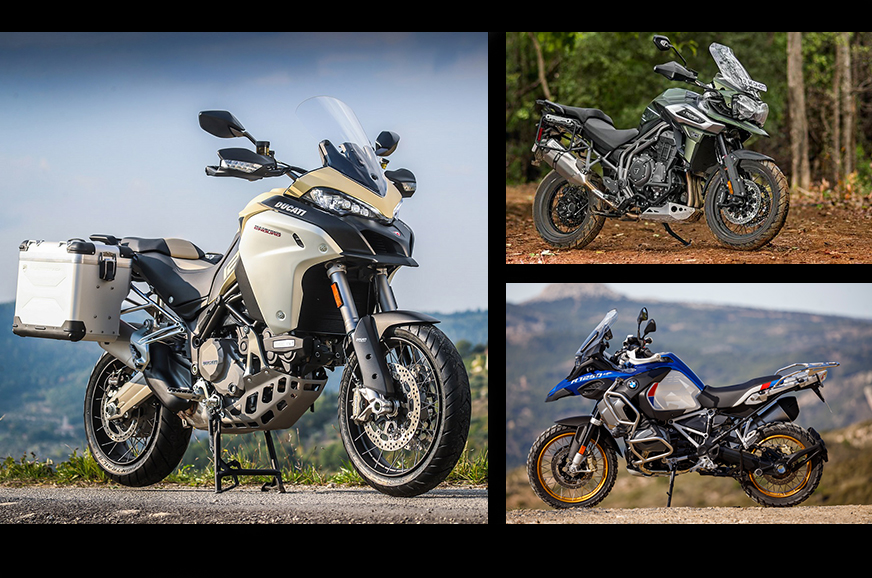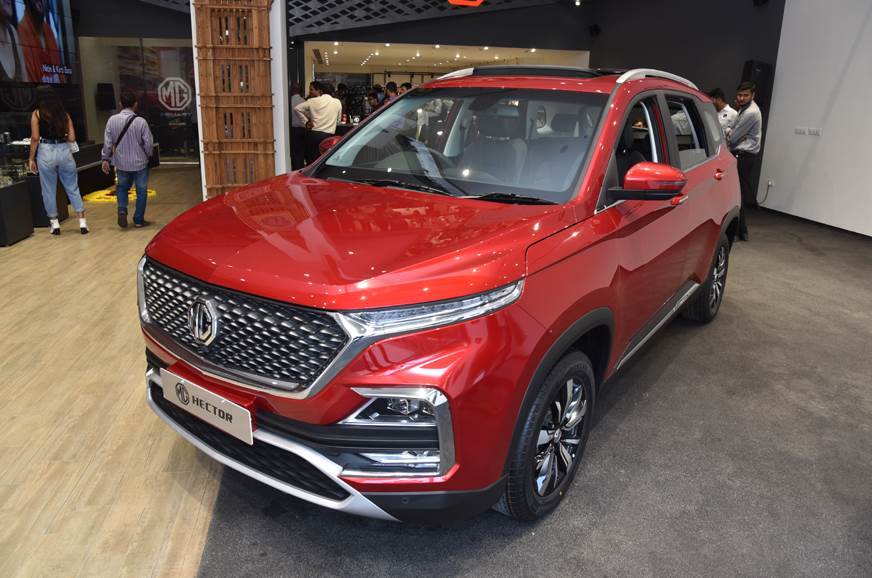
Ducati has just launched the Multistrada 1260 Enduro in India, with prices starting at Rs 19.99 lakh. An off-road-oriented version of the standard Multistrada, the Enduro range enhances the adventurer-tourer status of the regular model, which is already a very versatile motorcycle. Given its off-road-ready design and prowess, the Enduro 1260 finds itself in some very capable company, namely, the BMW R 1250 GS Adventure, a bike that’s considered the quintessence of the segment, and the Triumph Tiger 1200 XCx, another bike that’s designed to tread on and off the road with equal potency. We compare the specs of the three motorcycles to see how they stack up.
Powertrain:
The engines on all three motorcycles displace over 1,200cc, and use different layouts as well. The 1,262cc L-twin on the Enduro is the same as that on the regular Multistrada and produces 158.3hp at 9,500rpm and 128Nm of torque at 7,500rpm. It also features Ducati’s Testastretta DVT (Desmodromic Variable Timing), which is the Italian manufacturer’s version of variable valve timing. According to Ducati, it allows for 85 percent of maximum torque to be available below 3,500rpm, with a 17 percent increase at 5,500rpm as compared to the torque curve on the engine of the previous model. Likewise, BMW also equipped its flagship ADV with similar technology (called ShiftCam) when the R 1250 GS range was introduced in place of the R 1200 GS line-up. The 1,254cc boxer-twin engine is capable of producing peak figures of 136hp at 7,750rpm and 143Nm of torque at 6,250rpm. The Tiger 1200 XCx doesn’t feature variable valve timing technology, and so it won’t have as consistent a power or torque curve as the other two motorcycles. However, the 1,215cc triple produces more power than the BMW, with 141hp at 9,350rpm and a peak torque of 122Nm at 7,600rpm. All three motorcycles feature a 6-speed gearbox and bi-directional quick-shifters.
| Powertrain | |||
| Ducati Multistrada 1260 Enduro | BMW R 1250 GS Adventure | Triumph Tiger 1200 XCx | |
| Engine | 1262cc, L-twin, liquid-cooled | 1254cc, flat-twin, air/liquid-cooled | 1215cc, inline-triple, liquid-cooled |
| Power | 158.3hp at 9500rpm | 136hp at 7750rpm | 141hp at 9350rpm |
| Torque | 128Nm at 7500rpm | 143Nm at 6250rpm | 122Nm at 7600rpm |
| Gearbox | 6-speed | 6-speed | 6-speed |
| Power-to-weight ratio | 860mm | 890-910mm | 835 - 855 mm |
Chassis:
One thing that the three massive ADVs have in common is that they are all substantially heavy. The Ducati weighs 254kg, the BMW weighs 268kg and while Triumph hasn’t revealed a kerb weight for the 1200XCx, a dry weight of 251kg means a kerb weight of well over 270kg, considering the 20-litre fuel tank. Speaking of which, the other two have even larger fuel tanks, with a capacity of 30 litres each. In terms of suspension, the 1260 Enduro features Ducati Skyhook suspension at either end, the 1250 GS Adventure uses BMW’s Telelever system at the front and Paralever suspension at the rear, while on the 1200XCx, suspension duties are taken care of by WP-branded units. The GS is capable of 210mm/220mm (front/rear) of suspension travel, which is significantly more than the 190mm/193mm (front/rear) on the 1200 XCx. Meanwhile, Ducati has listed the wheel travel of the 1260 Enduro as 185mm/185mm (front/rear).
Now, large ADVs are usually tall motorcycles, and of the lot, the GS is the tallest and its seat height of 890-910mm will certainly make it more challenging to ride for shorter riders. On the Enduro, you will be perched 860mm off the ground, while the Tiger has the lowest saddle, at 835-855mm. It’s worth noting that the Ducati does have a low seat height option that reduces it by 20mm, while the optional low seat on the BMW will make it more accessible by 40mm.
| Chassis | |||
| Ducati Multistrada 1260 Enduro | BMW R 1250 GS Adventure | Triumph Tiger 1200 XCx | |
| Wheelbase | 1592mm | 1504mm | 1520mm |
| Seat height | 860mm | 890-910mm | 835-855mm |
| Brakes (f) | 320mm dual discs | 305mm dual discs | 305mm dual discs |
| Brakes (r) | 265mm disc | 276mm disc | 282mm disc |
| Suspension (f) | 48mm USD fork | 37mm BMW Telelever suspension | 48mm USD fork |
| Suspension (r) | Monoshock | BMW Paralever suspension | Monoshock |
| Tyres (f) | 120/70 ZR19 | 120/70 R19 | 120/70 R19 |
| Tyres (r) | 170/60 ZR17 | 170/60 R17 | 170/60 R17 |
| Fuel capacity | 30 litres | 30 litres | 20 litres |
| Kerb weight | 254kg | 268kg | NA |
Features:
Riding a motorcycle that weighs more than a quarter of a ton and produces upwards of 130hp can go south very soon. Luckily for us, all three come with a host of electronic aids and safety features that keep things in check. The Multistrada Enduro 1260 is equipped with cornering ABS, eight levels of traction and wheelie control, four riding modes (Sport, Touring, Urban and Enduro), three power output modes, cruise control, cornering lights and a hill-start assist. The 5.0- inch TFT display also allows smartphone pairing and comes with the Ducati Multimedia System that integrates phone and media functionality. The Bimmer has its fair share of tech as well – it gets two riding modes (Rain and Road), hill-start assist and a 6.5-inch TFT display, which is the crispest in the segment and also offers phone connectivity and media integration. An additional Rs 3.7 lakh will also get you the Pro package that comes with a more sophisticated ABS system, dynamic traction control, Dynamic ESA, HSC (Hill-Stability Control) Pro and the Dynamic Brake Assistant, which cuts off throttle in an emergency braking situation. On the Tiger 1200, electronics include a 5.0-inch TFT instrument cluster, five rider modes (Road, Off-road, Off-Road Pro, Sport and Track), as well as ABS and traction control, which accounts for lean angle and cruise control.
Verdict:
The 1260 Enduro, the 1250 GS Adventure and the Tiger 1200 XCx, all fall into the same big ADV category, but are very unique in their own right. Prices for the Ducati 1260 Enduro start at Rs 19.99 lakh, Rs 18.25 lakh for the BMW 1250 GS Adventure and Rs 17 lakh for the Triumph Tiger 1200 XCx. Of the lot, the BMW and Ducati are more expensive but offer a bit more with the variable valve technology and a more sophisticated electronics package. That said, the Triumph isn’t far behind in terms of tech and also produces more power than the BMW. To pick the best bike of the bunch would require us to ride them back to back, but since this is a specifications comparison, the Ducati takes the top spot with the most powerful engine and its extensive electronics, not too far ahead from the GS.
from Autocar India https://ift.tt/30rSnWH
via IFTTT

No comments:
Post a Comment